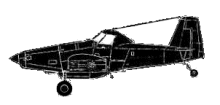
ASN Wikibase Occurrence # 298142
This information is added by users of ASN. Neither ASN nor the Flight Safety Foundation are responsible for the completeness or correctness of this information.
If you feel this information is incomplete or incorrect, you can submit corrected information.
| Date: | Wednesday 9 August 2017 |
| Time: | 06:30 LT |
| Type: |  Air Tractor AT-802A |
| Owner/operator: | Lesco Aviation Inc. |
| Registration: | N528MB |
| MSN: | 802A-0350 |
| Year of manufacture: | 2010 |
| Total airframe hrs: | 4349 hours |
| Engine model: | Pratt & Whitney Canada PT6A-67AG |
| Fatalities: | Fatalities: 0 / Occupants: 1 |
| Aircraft damage: | Substantial |
| Category: | Accident |
| Location: | Galesburg, Illinois -
 United States of America United States of America
|
| Phase: | Manoeuvring (airshow, firefighting, ag.ops.) |
| Nature: | Agricultural |
| Departure airport: | Monmouth, IL (C66) |
| Galesburg, IL | |
| Investigating agency: | NTSB |
| Confidence Rating: |
The pilot was on an agricultural flight when the engine lost total power. The pilot completed a forced landing in a nearby field, but he was unable to maintain directional control of the airplane after it landed in the dense soybean crop. The outboard portion of the right wing and aileron were substantially damaged during the forced landing.
A postaccident engine examination revealed that a single 1st stage compressor rotor airfoil had fractured near its root. The fatigue crack originated from a thinned leading edge due to significant erosion at the bottom of the airfoil pressure side; however, the exact location of the fatigue origin could not be determined because it had been obliterated by the erosion. The observed fracture features were consistent with a crack that had progressed in highcycle fatigue. Dimensional measurements of the fractured airfoil and the two adjacent airfoils revealed that they were under the minimum requirement for an airfoil. The airfoils also exhibited evidence of fine wear scratches, characteristic of fine abrasive particles impacting the airfoil, and thinning of their leading edges. The underlying cause of the airfoil erosion could not be determined with certainty; however, based on the observed damage, it was possibly the result of environmental conditions. The engine had accumulated 4,349.3 hours since new and had never been overhauled. The engine manufacturer's recommended time between overhaul (TBO) was 3,000 hours; however, the operator was not required to comply with the recommended TBO interval under current regulations due to the type of operation.
Probable Cause: A total loss of engine power due to the fracture of a single 1st stage compressor rotor airfoil in high-cycle fatigue as a result of the erosion and thinning of the airfoil's leading edge. Contributing to the fractured airfoil and loss of engine power was the operator's decision to operate the engine past the manufacturer's recommended time between overhaul.
Accident investigation:
 |
|
Sources:
NTSB CEN17LA309
Location
Revision history:
| Date/time | Contributor | Updates |
|---|---|---|
| 15-Oct-2022 13:35 | ASN Update Bot | Added |
Corrections or additions? ... Edit this accident description
The Aviation Safety Network is an exclusive service provided by:


 ©2024 Flight Safety Foundation
©2024 Flight Safety Foundation